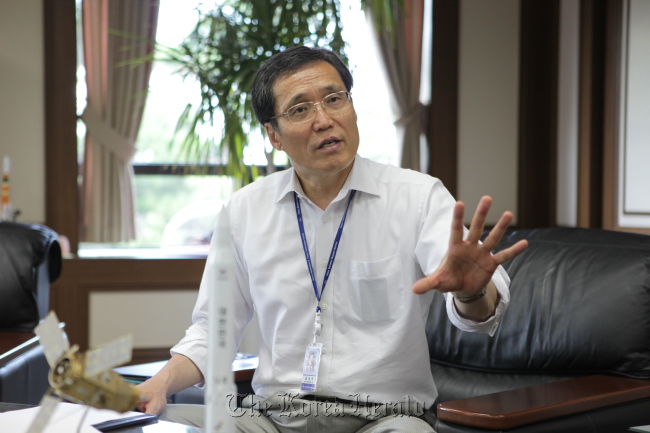Space agency chief says lessons from two failed attempts to help successful launch of KSLV-1 in October
The chief of Korea’s aerospace agency expressed optimism ahead of the launch of the nation’s first space vehicle slated for October.
“Everything is under control and I’m sure we’ll have a successful launch in October,” Kim Seung-jo, president of Korea Aerospace Research Institute, said in an interview with The Korea Herald.
Korea failed in its previous two attempts to launch its own rocket in 2009 and 2010. KARI has learned crucial lessons from the experiences.
The KSLV-1, known as Naro-1, is a two-stage rocket built in cooperation with Russia. Russia’s Khrunichev Space Research designed and manufactured the lower part and KARI developed the upper part.
The chief of Korea’s aerospace agency expressed optimism ahead of the launch of the nation’s first space vehicle slated for October.
“Everything is under control and I’m sure we’ll have a successful launch in October,” Kim Seung-jo, president of Korea Aerospace Research Institute, said in an interview with The Korea Herald.
Korea failed in its previous two attempts to launch its own rocket in 2009 and 2010. KARI has learned crucial lessons from the experiences.
The KSLV-1, known as Naro-1, is a two-stage rocket built in cooperation with Russia. Russia’s Khrunichev Space Research designed and manufactured the lower part and KARI developed the upper part.

The upper stage is already completed and placed at the Naro Space Center in Goheung, South Jeolla Province. The lower stage will be delivered from Russia before the end of August, according to the head of the Korean space agency.
Kim, who spent nearly two decades teaching at Seoul National University, took the helm of KARI in 2011.
In its initial launch, the Naro-1 successfully reached its target orbit, 300 kilometers from the Earth’s surface, but failed to place a satellite into orbit after the payload fairing did not open properly.

“We carried out more than 400 tests to find and correct the errors in the fairing system,” he said. “We can now assure that there will be no more problems.”
During its second attempt, the rocket exploded 137 seconds after lift off.
What caused the explosion has still not been clearly identified, but one possibility is a malfunction of the Flight Termination System in the upper stage rocket, according to Kim.
The purpose of the FTS is to self-destruct the vehicle when it travels outside of the safety zone. But to prevent any risk, the FTS system won’t be used this time, he said.
“We only installed it as a precaution, even without it no debris will fall in an inhabited area,” he explained.
The explosion was a crucial lesson for the Korean space program.
“We learned a lot through the investigation with Russia. We now know what systems we need to look at and what kinds of sensors are necessary to detect when the rocket fails,” he said.
Once KARI succeeds in launching the KSLV-1, it plans to develop a three-stage indigenous space rocket, the KSLV-2, by 2021.
He said he believes the country should look to a private space firm called SpaceX for the future space model.
The California-based firm’s Falcon 9 is regarded as one of the most cost-effective space vehicles ever built, he said.
The two-stage rocket uses the SpaceX’s Merlin engine, which provides a 66-ton thrust using liquid oxygen and kerosene.
The first stage has nine Merlin engines clustered together that can generate nearly 600 tons of thrust. And the second stage, with a single Merlin engine, is simply a shorter version of the first stage and uses most of the same material.
This unique design allows significant cost-saving in vehicle production, according to Kim.
“We should also develop such a cost-effective model as we don’t have much money like other countries. Also, we don’t have much time,” he said.
According to him, the KARI will now focus on developing a liquid-fueled 75-ton thrust engine by 2018.
The question, however, is whether it has the knowledge and technology to develop the engine.
But he claimed KARI has learned a lot through the Naro-1 project. In particular it learned some key technologies needed to develop a liquid-fueled rocket engine.
Building a 75-ton thrust engine, however, is a still long way off, he admitted.
“We still don’t have the facilities to test a large-scale rocket engine and test-fly it. We need to upgrade the Naro Space Center,” he said.
But in order to do that KARI will have to secure a budget of more than 300 billion won ($264 million). And it will largely depend on the result of the Naro-1 launch, Kim said.
“A successful launch will be a stepping stone for our long-term goal, so we’re making our utmost effort to make it success this time,” he added.
By Oh Kyu-wook (596story@heraldcorp.com)
-
Articles by Korea Herald







![[Graphic News] More Koreans say they plan long-distance trips this year](http://res.heraldm.com/phpwas/restmb_idxmake.php?idx=644&simg=/content/image/2024/04/17/20240417050828_0.gif&u=)
![[KH Explains] Hyundai's full hybrid edge to pay off amid slow transition to pure EVs](http://res.heraldm.com/phpwas/restmb_idxmake.php?idx=644&simg=/content/image/2024/04/18/20240418050645_0.jpg&u=20240419100350)






![[From the Scene] Monks, Buddhists hail return of remains of Buddhas](http://res.heraldm.com/phpwas/restmb_idxmake.php?idx=652&simg=/content/image/2024/04/19/20240419050617_0.jpg&u=20240419175937)

![[KH Explains] Hyundai's full hybrid edge to pay off amid slow transition to pure EVs](http://res.heraldm.com/phpwas/restmb_idxmake.php?idx=652&simg=/content/image/2024/04/18/20240418050645_0.jpg&u=20240419100350)

![[Today’s K-pop] Illit drops debut single remix](http://res.heraldm.com/phpwas/restmb_idxmake.php?idx=642&simg=/content/image/2024/04/19/20240419050612_0.jpg&u=)